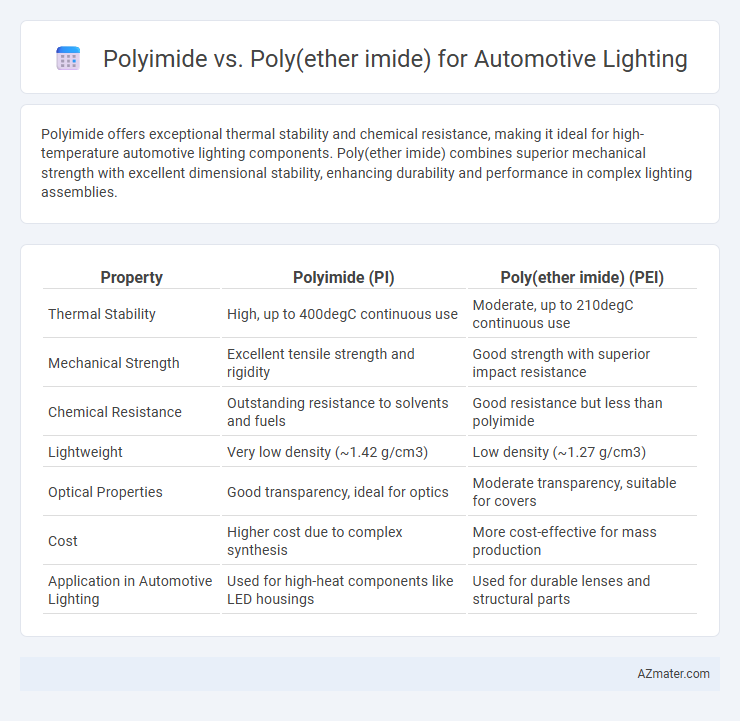Polyimide offers exceptional thermal stability and chemical resistance, making it ideal for high-temperature automotive lighting components. Poly(ether imide) combines superior mechanical strength with excellent dimensional stability, enhancing durability and performance in complex lighting assemblies.
Table of Comparison
| Property | Polyimide (PI) | Poly(ether imide) (PEI) |
|---|---|---|
| Thermal Stability | High, up to 400degC continuous use | Moderate, up to 210degC continuous use |
| Mechanical Strength | Excellent tensile strength and rigidity | Good strength with superior impact resistance |
| Chemical Resistance | Outstanding resistance to solvents and fuels | Good resistance but less than polyimide |
| Lightweight | Very low density (~1.42 g/cm3) | Low density (~1.27 g/cm3) |
| Optical Properties | Good transparency, ideal for optics | Moderate transparency, suitable for covers |
| Cost | Higher cost due to complex synthesis | More cost-effective for mass production |
| Application in Automotive Lighting | Used for high-heat components like LED housings | Used for durable lenses and structural parts |
Introduction to Polyimide and Poly(ether imide) in Automotive Lighting
Polyimide and Poly(ether imide) are high-performance polymers crucial in automotive lighting due to their excellent thermal stability, chemical resistance, and electrical insulation properties. Polyimide offers exceptional heat resistance and mechanical strength, making it ideal for components exposed to high temperatures in headlamp assemblies. Poly(ether imide) combines similar thermal and chemical resistance with improved impact resistance and dimensional stability, enhancing durability in complex lighting systems and connectors.
Chemical Structure and Composition: PI vs PEI
Polyimide (PI) features rigid aromatic imide rings connected by flexible linkages, providing exceptional thermal stability and chemical resistance essential for automotive lighting applications. Poly(ether imide) (PEI) incorporates ether linkages into the polyimide backbone, enhancing toughness and impact resistance while maintaining high heat deflection temperature and dimensional stability. The presence of ether groups in PEI improves processability and mechanical flexibility compared to PI, making PEI suitable for complex automotive lighting components requiring both durability and precision molding.
Thermal Stability Comparison for Lighting Applications
Polyimide exhibits exceptional thermal stability with continuous use temperatures up to 300degC, making it suitable for high-temperature automotive lighting applications. Poly(ether imide) (PEI) offers a slightly lower thermal endurance, typically up to 170-200degC, but provides better dimensional stability and resistance to hydrolysis under automotive conditions. For lighting applications requiring prolonged exposure to high heat and harsh environments, polyimide's superior thermal resistance ensures durability, while PEI balances thermal performance with improved mechanical properties.
Mechanical Strength and Durability Differences
Polyimide exhibits superior thermal stability and mechanical strength, making it ideal for harsh automotive lighting environments subjected to high temperatures and mechanical stress. Poly(ether imide) offers enhanced impact resistance and improved flexibility, contributing to better durability against mechanical shocks and vibrations commonly experienced in automotive applications. The choice between polyimide and poly(ether imide) hinges on the balance between rigidity and impact toughness required for specific lighting components.
Optical Properties Relevant to Automotive Lighting
Polyimide exhibits high thermal stability and excellent mechanical strength but tends to have a yellowish tint and lower optical clarity, which can impact light transmission in automotive lighting applications. Poly(ether imide) (PEI) offers superior optical transparency with a colorless appearance and higher light transmittance, enhancing the efficiency and brightness of automotive light lenses and covers. The improved UV resistance and lower haze of PEI make it more suitable than polyimide for components requiring precise light diffusion and clarity in vehicle lighting systems.
Electrical Insulation Performance
Polyimide exhibits exceptional electrical insulation properties with high dielectric strength and thermal stability, making it suitable for automotive lighting components exposed to extreme conditions. Poly(ether imide) offers comparable electrical insulation but with enhanced hydrolytic stability and mechanical toughness, which improves durability in automotive lighting applications subjected to moisture and vibration. The choice between polyimide and poly(ether imide) depends on the specific environmental requirements and electrical performance criteria of the automotive lighting system.
Processability and Manufacturing Considerations
Polyimide offers excellent thermal stability and chemical resistance but presents challenges in processing due to its high melting point and limited solubility, often requiring complex curing cycles for automotive lighting applications. Poly(ether imide) provides superior processability with a lower glass transition temperature and better solubility, enabling injection molding and extrusion, which streamlines manufacturing and reduces cycle times. Selecting poly(ether imide) enhances production efficiency in automotive lighting while maintaining adequate thermal performance for under-hood environments.
Cost Analysis: PI vs PEI
Polyimide (PI) typically incurs higher raw material and processing costs compared to Poly(ether imide) (PEI) due to its superior thermal stability and chemical resistance, making it ideal for high-performance automotive lighting applications. PEI offers cost advantages with lower material expenses and easier manufacturability, translating to reduced overall production costs while maintaining adequate mechanical strength and temperature resistance. Cost analysis reveals PEI as the more economically viable choice for mass-produced automotive lighting components without significant compromise on performance.
Application Case Studies in Automotive Lighting
Polyimide and Poly(ether imide) (PEI) are critical materials in automotive lighting, with case studies showing polyimide's superior thermal stability and chemical resistance for flexible LED circuit substrates. PEI demonstrates excellent mechanical strength and dimensional stability, making it ideal for structural lighting components exposed to high temperatures and mechanical stress. Application case studies highlight polyimide's use in flexible displays and PEI's role in robust lamp housings, ensuring durability and performance in advanced automotive lighting systems.
Conclusion: Material Selection Guidelines for Automotive Lighting
Polyimide offers excellent thermal stability and chemical resistance, making it suitable for high-temperature automotive lighting environments. Poly(ether imide) provides superior mechanical strength and impact resistance, enhancing durability under vibration and mechanical stress. Selecting between polyimide and poly(ether imide) depends on the specific application requirements, prioritizing thermal endurance for heat-exposed components and mechanical robustness for structural parts in automotive lighting systems.

Infographic: Polyimide vs Poly(ether imide) for Automotive Lighting
 azmater.com
azmater.com